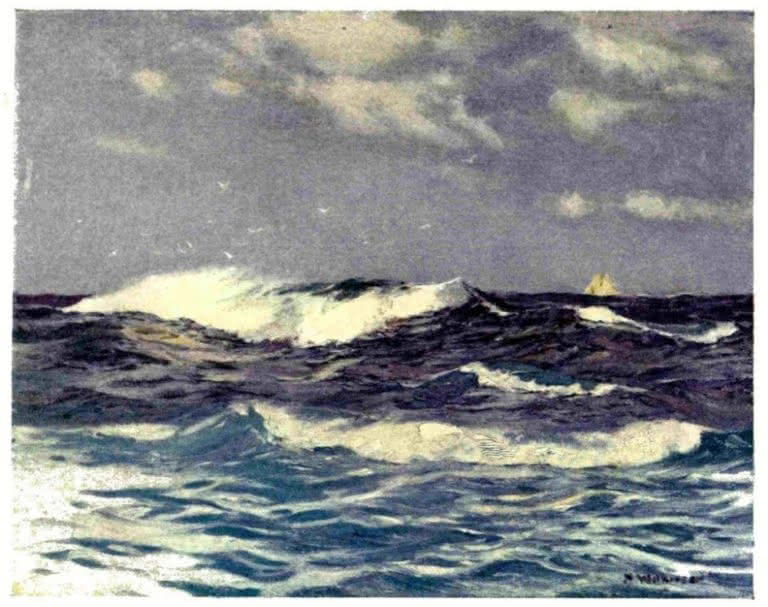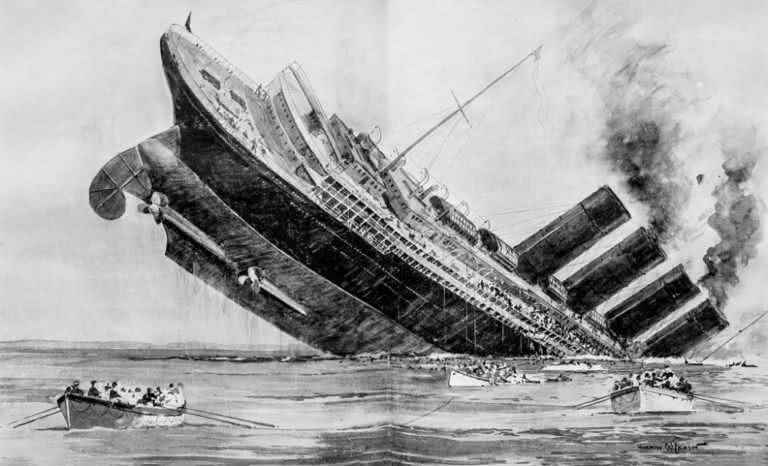Project Gutenberg regularly adds classic books and magazines, some famous and many forgotten, to its vast library. One of its most recent additions is a book titled British Marine Painting. Published in 1919, the book unsurprisingly contains many marine paintings by artists from the British Empire. For this article, I will write a bit about The Wave, a painting by the renowned British marine artist, Norman Wilkinson (1878-1971).
“The Wave” by Norman Wilkinson
Below you will find Norman Wilkinson’s The Wave as it appeared in British Marine Painting:

A.L. Baldry, an art historian and writer, added commentary about Norman Wilkinson and about The Wave specifically.
Regarding Wilkinson, Baldry opined:
Norman Wilkinson is a versatile artist who does many things well, and who yields to no one at the present time in knowledge of the pictorial chances which the sea provides.
The book includes three paintings by Wilkinson. Of these three, Baldry took the view that The Wave was “the most arresting in many ways.” Having praised Wilkinson for being “a very acute student of wave movement,” Baldry expressed what made The Wave a standout work in his learned opinion:
[I]t has such an unusual amount of vitality, it is so seriously observed and yet so free and unlaboured, and it is so correct not only in action but also in matters of lighting and reflection and of colour variation as well. This is an instance of the happy alliance of the science and art of marine painting to bring about a perfectly balanced result.
The Wave was one of several paintings to “arrest” my attention when I scrolled through the book. I noted the “vitality” in the painting, the beautiful blues and the movements of the waves and the birds in the sky. After reading Baldry’s opinion of the piece, I took greater note of the outstanding variety in the lighting.
A Bit More on Norman Wilkinson
Wikipedia notes that Wilkinson was known primarily for his marine paintings throughout his long and decorated career. He worked with oils, watercolors, and drypoint. I immediately recognized one of his works featured on his Wikipedia page – his illustration of the sinking of the RMS Lusitania.

Wilkinson and Dazzle Camouflage
In addition to producing many maritime paintings and sketches, Wilkinson contributed to naval warfare. Wilkinson was the man behind “dazzle camouflage,” that is, painting naval vessels not to conceal them, but rather to confuse German U-boats viewing the ships through a periscope. The idea involved painting ships with stripes and abstract shapes, making them look quite a bit more “modern” than Wilkinson’s own artwork. He was serving as a reserve officer in the Royal Navy during the First World War when he introduced the idea.
A History article includes some insights from Wilkinson. He had noted that he was of the view that it was impossible to make a large naval vessel invisible. However, in light of the slim margin for error that German U-boats had when aiming torpedoes, their targets did not need to be invisible to avoid direct hits. Wilkinson explained that his idea “was exploiting the limited view of the periscope.”
The Royal Navy authorized Wilkinson to work on his idea, and by 1917 it directed that British merchant vessels receive the dazzle camouflage treatment. In 1918, the U.S. Navy invited Wilkinson to advise it on implementing its own dazzle camouflage program. The effectiveness of dazzle camouflage in practice in World War I remains unclear, but it was widely adopted. Although the method largely fell out of favor after World War I, U.S. and Royal Navy vessels used it to a limited extent in World War II.